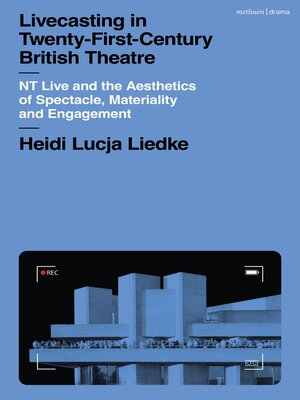Livecasting in Twenty-First-Century British Theatre
ebook ∣ NT Live and the Aesthetics of Spectacle, Materiality and Engagement
By Heidi Lucja Liedke

Sign up to save your library
With an OverDrive account, you can save your favorite libraries for at-a-glance information about availability. Find out more about OverDrive accounts.
Find this title in Libby, the library reading app by OverDrive.



Search for a digital library with this title
Title found at these libraries:
| Library Name | Distance |
|---|---|
| Loading... |
This significant contribution to the study of the live and recorded broadcasting of stage plays focuses on National Theatre Live a decade after its launch in 2009. Assessing livecasting through the concepts of spectacle, materiality and engagement, it examines the role played by audiences in livecasting. Illustrated by in-depth analyses of recent NT Live shows, including A Midsummer Night's Dream (2019), Antony and Cleopatra (2018) and Small Island (2019), the book is complemented by insights from practitioners involved in the making of the livecasts. Finally, livecasting is contextualized within recently emerged forms of Covidian (virtual) theatre during the pandemic in order to offer some thoughts on the future of the genre of theatrical performance.
Combining lively analyses of recent theatre performances with auto-ethnographic accounts, Heidi Lucja Liedke turns to 20th-century thinkers such as Walter Benjamin and Bertolt Brecht in order to understand livecasting's place in a continuum of developments taking place on the borders of media, film and performance for the past 100 years.
As well as embedding livecasting in its historical context of 19th-century electrophone technology, Liedke assesses its position in contemporary discourses on the meaning of theatre for spectators in the pre- and post-pandemic moment, and points towards the form's future.
Combining lively analyses of recent theatre performances with auto-ethnographic accounts, Heidi Lucja Liedke turns to 20th-century thinkers such as Walter Benjamin and Bertolt Brecht in order to understand livecasting's place in a continuum of developments taking place on the borders of media, film and performance for the past 100 years.
As well as embedding livecasting in its historical context of 19th-century electrophone technology, Liedke assesses its position in contemporary discourses on the meaning of theatre for spectators in the pre- and post-pandemic moment, and points towards the form's future.







